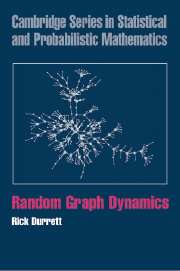
-
Select format
-
- Publisher:
- Cambridge University Press
- Publication date:
- August 2009
- October 2006
- ISBN:
- 9780511546594
- 9780521150163
- Dimensions:
- Weight & Pages:
- Dimensions:
- (253 x 215 mm)
- Weight & Pages:
- 0.42kg, 220 Pages
You may already have access via personal or institutional login
Book description
The theory of random graphs began in the late 1950s in several papers by Erdos and Renyi. In the late twentieth century, the notion of six degrees of separation, meaning that any two people on the planet can be connected by a short chain of people who know each other, inspired Strogatz and Watts to define the small world random graph in which each site is connected to k close neighbors, but also has long-range connections. At a similar time, it was observed in human social and sexual networks and on the Internet that the number of neighbors of an individual or computer has a power law distribution. This inspired Barabasi and Albert to define the preferential attachment model, which has these properties. These two papers have led to an explosion of research. The purpose of this book is to use a wide variety of mathematical argument to obtain insights into the properties of these graphs. A unique feature is the interest in the dynamics of process taking place on the graph in addition to their geometric properties, such as connectedness and diameter.
Reviews
‘A very valuable addition to the growing field of random graphs, providing a systematic coverage of these novel models.’
Michael Krivelevich Source: Mathematical Reviews
‘The book is written in a friendly, chatty style, making it easy to read; I very much like that. In summary, Random Graph Dynamics is a nice contribution to the area of random graphs and a source of valuable insights.’
Malwina J. Luczak Source: Journal of the American Statistical Association
Contents
Metrics
Altmetric attention score
Full text views
Full text views help Loading metrics...
Loading metrics...
* Views captured on Cambridge Core between #date#. This data will be updated every 24 hours.
Usage data cannot currently be displayed.
Accessibility standard: Unknown
Why this information is here
This section outlines the accessibility features of this content - including support for screen readers, full keyboard navigation and high-contrast display options. This may not be relevant for you.
Accessibility Information
Accessibility compliance for the PDF of this book is currently unknown and may be updated in the future.


